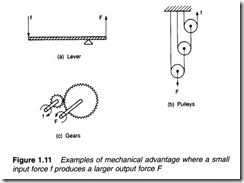Pascal’s law
Pressure in an enclosed fluid can be considered uniform throughout a practical system. There may be small differences arising from head pressures at different heights, but these will generally be negligible compared with the system operating pressure. This equality of pressure is known as Pascal’s law, and is illustrated in Figure 1.9 where a force of 5 kgf is applied to a piston of area 2 cm2. This produces a pressure of 2.5 kgf cm-2 at every point within the fluid, which acts with equal force per unit area on the walls of the system.
Suppose the base of the left hand tank is 0.1 x 0.1 m to give a total area of 100cm2 . The total force acting on the base will be 250 kgf. If the top of the right hand tank is 1 m x 1.5 m, a surprisingly large upwards force of 37,500 kgf is developed. Note, the size of the connecting pipe has no effect. This principle explains why it is possible to shear the bottom off a bottle by applying a small force to the cork, as illustrated in Figure 1.9b.
The applied force develops a pressure, given by the expression:
Expression 1.10 shows an enclosed fluid may be used to magnify a force. In Figure 1.10 a load of 2000 kg is sitting on a piston of area 500 cm2 (about 12 em radius). The smaller piston has an area of 2 cm2 . An applied force f given by:
will cause the 2000 kg load to rise. There is said to be a mechani cal advantage of 250.
Energy must, however, be conserved. To illustrate this, suppose the left hand piston moves down by 100 em (one metre). Because
we have assumed the fluid is incompressible, a volume of liquid 200 cm2 is transferred from the left hand cylinder to the right hand cylinder, causing the load to rise by just 0.4 em. So, although we have a force magnification of 250, we have a movement reduction of the same factor. Because work is given by the product of force and the distance moved, the force is magnified and the distance moved reduced by the same factor, giving conservation of energy. The action of Figure 1.10 is thus similar to the mechanical systems of Figure 1.11 which also exhibit mechanical advantage.
The principle of Figure 1.10 is widely used where a large force is required with small movement. Typical examples are clamps, presses, hydraulic jacks and motor car brake and clutch operating mechanisms.
It should be noted that pressure in, say, a cylinder is determined solely by load and piston area in the steady state, and is not dependent on velocity of the piston once a constant speed has been achieved. Relationships between force, pressure, flow and speed are illustrated in Figure 1.12.
In Figure 1.12a, fluid is delivered to a cylinder at a rate of Q cm3 s-1. When the inlet valve is first opened, a pressure spike is observed as the load accelerates, but the pressure then settles back
Incoming search terms:
- what is the importance of pascals law in hydraulics
- does pascals law apply to pneumatic systems
- pascewr hydraulic law
- pascals law pneumatics
- EXplain the pascal law and significance in hydraulic and pneumatic
- different laws of fluid that govern the hydraulic and pneumatic system
- pascal pneumatics
- laws that govern hydraulic and pneumatic system
- pascal laws significance in hydraulic and pneumatics
- pascals law significance in hydraulic and pneumatic system
- pascals law its significance in hydraulic and pneumatic
- pascals law in air pneumatics
- pneumatic and pascal
- Pneumatic system pascals law
- principle of pascals law and ralation to pneumatic/
- pascals principle with respect to pneumatic
- significance hydraulic and pneumatic
- what are the different laws that govern hydraulic and pneumatic systems? state the laws
- WATER HYDRAULICS mail
- stete pascal law in hydrolic and pneumatic system
- State the pascals laws And its significance in hydraulic and pneumatic system
- state the Pascal principle in relation to hydraulics and pneumatic systems
- significance of pascals law in hydraulucs and pnumetatics
- Significance of pascals law in hydraulic and pneumatic
- significance of pascal law in hydraulics and pneumatics
- significance of pascal law in hydraulic and pneumatics
- significance of pascal law for hydtaulic and pneumatic
- significaNce of pascal law
- pascals law and its significance in hydraulics
- pascals law and its significance in hudraulic ang pneumatic system
- law of pneumatics
- is pascals law is applicable for air
- is pascal law applicable to pneumatic
- hydraulics and pneumatics pascale
- How does Pascals law apply to hydraulics?
- how can pascal\s law be applied to hydraulic
- governing law in hydraulics and pneunatics
- Explain the significance of pascals law in hydraulic and pneumatic system
- diff law that govern the hydraulicand pneumatic systems
- laws of govern in hydraulic and pneunatics
- laws of hydroulic and panamatics
- Pascal law significance in hydraulic pneumatic
- pascal law pneumatic cylinder
- pascal law in hydraulic and pneumatics
- Pascal law application on pneumatic
- Pascal law and its significance in hydraulics and pneumatics system
- pascal law and its significance
- parker pascal law
- PacSeal Hydraulics mail
- outline instances where pascals law is applied




